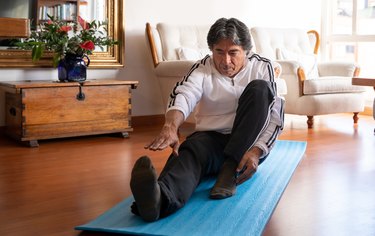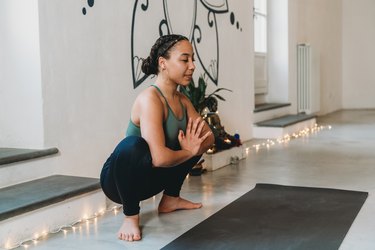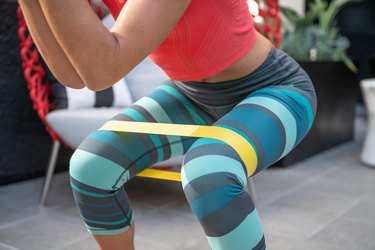
Being flexible means more than just being able to touch your toes or do a split. It also means being able to move your body and complete daily tasks like tying your shoelaces, getting out of bed and carrying groceries without discomfort, pain or restrictions.
However, as we age, we lose a small amount of our flexibility. And experts agree that increases our risk of injury, hinders our ability to perform daily activities with ease and may add to a decline in overall quality of life.
Video of the Day
Video of the Day
But what causes changes in flexibility as we age, and are there things we can do to preserve and improve it? Here's what you need to know, according to experts.
What Is Flexibility
Flexibility, according to the American College of Sports Medicine, refers to the ability of soft tissues (such as muscles, ligaments and tendons) to move and stretch seamlessly throughout a complete range of motion. Ideally you can do all this without causing pain or restrictions, Kemly Philip, MD, PhD, a physical medicine and rehabilitation physician with UTHealth Houston and Memorial Hermann, tells LIVESTRONG.com.
"This means that soft tissues, such as a muscle, can stretch and contract freely, like a new rubber band out of the packaging," Dr. Philip says. Simply put, flexibility is how far you can move muscles and joints in any given direction.
However, multiple factors can impact your flexibility, according to Tyler Detmer, PT, DPT, an orthopedic physical therapist at Washington University in St. Louis. Muscle length, neuromuscular control factors (how well your brain controls your muscles), individual anatomy and unique body structure and how different body tissues work together are just a few. Age, gender, activity level or injury might also come into play.
"When most people think of flexibility, they think of being able to stretch to the ground with their hands or pulling their arms behind their torso. To be flexible means far more than this and can have a significant impact on functionality throughout our daily lives," Detmer says.
Flexibility vs. Mobility
According to Dr. Philip, while flexibility is about how well a muscle can stretch, mobility refers to how well a joint can move through its full range of motion. You might have flexible hamstrings, but it's good joint mobility that lets you touch your toes, climb stairs, or get up from a chair without any trouble.
Detmer adds that mobility involves your ability to actively control your body or joint within your full range of motion. The key difference between flexibility and mobility is the "active control of the body."
While you might be flexible through a certain movement, like during a passive stretch (where you stay in one position for a set time), you may still struggle to perform the same movement on your own.
"One common example of this would be when someone is having their hamstring stretched when they are lying on their back," he says. "After stretching for several minutes, they'll see a short-term improvement in their flexibility, which may allow them to bend down to tie their shoes or pick up objects up off the floor.
On the other hand, mobility would be the individual's ability to perform these movements at all times, regardless of when they are stretched.
In general, flexibility is about how stretchy your muscles and soft tissues are, while mobility is about how well your joints move when you’re active. Both are crucial for your overall physical health and performance.
Why Flexibility Matters
Maintaining flexibility, particularly as we age, is a critical aspect of overall physical health and wellbeing, Detmer says. By allowing your joints to move more freely and your muscles to stretch further, good flexibility makes everyday activities and tasks, like turning one's head while driving, bending down to tie shoelaces, carrying groceries, or reaching for items, easier.
Dr. Philip points out that inadequate flexibility can lead to poor mobility, which, over time, can increase the risk of developing chronic musculoskeletal or spine-related pain.
"These functional limitations can restrict independence with activities that ultimately provide meaning, such as gardening or cooking, and can even be associated with the development of mood disorders such as anxiety or depression," Dr. Philip adds.
Flexibility also plays a critical role in injury prevention, Dr. Philip says. When your body can move within its natural range, it's better equipped to handle sudden movements or stressors without strain or damage. If your shoulder is not able to go through the full range of lifting your arm overhead, attempting to stow a carry-on on a flight puts you at a greater risk of injury or muscle strain.
One of the more common injuries resulting from poor flexibility is lower back pain, Detmer says, often caused by stiff leg muscles that pull the lower back into abnormal positions during movement.
While a consistent flexibility program isn't going to "100 percent prevent pain and reduce injury risk, it can significantly reduce the likelihood and severity of pain and problems with our functional activities," he says.
Why Flexibility Worsens With Age
One primary factor why flexibility tends to decline with age is because of the reduction in physical activity, particularly exercises that focus on stretching and strengthening, Dr. Philip says.
Changes in our lifestyle and habits, often accompanied by age-related medical conditions, can lead to a more sedentary lifestyle. This lack of physical activity can promote muscle shortening, resulting in decreased flexibility and limitations in joint range of motion or mobility, she adds.
Malachy McHugh, PhD, director of research at NISMAT, Manhattan Eye, Ear and Throat Hospital, tells LIVESTRONG.com that aging itself also has a direct impact on muscle and joint structures.
As we get older, we lose muscle mass and get weaker. As part of this process, McHugh explains, our muscles become shorter, and having shorter muscles decreases our functional range of motion.
"So, as we get older and move less, we will lose muscle mass and motion. The available motion in a joint or series of joints will change based on the demands placed on them," McHugh says. "Add to that the loss of muscle mass that is inevitable with aging, and you have difficulty reaching down to tie your shoelaces or to cut your toenails."
Other factors that can affect flexibility as we age are changes to the muscle and joint structure itself due to inflammatory conditions like arthritis, Dr. Philip adds. "These structural or inflammatory changes can affect the ability of muscles to passively stretch."
4 Ways to Preserve and Improve Flexibility As You Age
There are things you can do to maintain or improve flexibility in your later years, Detmer says.
"The more often we move our joints through their range of motion, the better we can maintain our flexibility and mobility," Detmer adds. "It takes consistency to create these changes in flexibility, but just because we are older does not prevent us from improving."
It's important to remember that promoting flexibility and mobility as we age will look different for every individual depending on their impairments or medical conditions, Dr. Philip says.
"You can be proactive by reaching out to a physical medicine and rehabilitation specialist or your primary care physician to oversee a focused physical therapy program," she adds. "This physiatrist-led approach can enable older individuals to maintain their flexibility, mobility and overall functional independence and physical wellbeing."
Here are the habits that experts recommend you do consistently to preserve and improve flexibility as you age.
1. Stretch Regularly
One thing that people can do to preserve and improve their flexibility is to stretch regularly for a few minutes a day, especially at the start and end of an exercise program, Dr. Philip says. Keep in mind that improving flexibility does not happen overnight — it's the result of regular and consistent stretching over time.
The two most common types of stretching she recommends that have been proven to be effective at increasing flexibility are static stretching and dynamic stretching. Static stretching involves stretches that you hold in place, while dynamic stretching is an active movement where joints and muscles go through a full range of motion.
"Static stretching, or holding a position for a certain amount of time, should be followed by dynamic stretching, where joints go through their range of motion in repetition," Dr. Philip says. "This can include exercises such as head rolls, leg swings, hip circles or lunges."
Detmer adds there are other exercises that you can focus on that will target flexibility, function, and movement:
"This is not an exclusive list and needs to be done appropriately, it should not be painful," he adds. "Start off easy and through a comfortable range of motion and try and move further and further as your body allows with improvements over the course of weeks and months."
If you notice any issues with movements or exercises, reach out to your medical provider or physical therapist for individual guidance.
2. Avoid Sitting for Long Periods
Another way to preserve flexibility is to avoid sitting for too long. When you sit for several hours, your muscles, particularly those in the lower back, hips and legs, are in a shortened position. When prolonged muscle shortening occurs, it can lead to a loss of flexibility and therefore limitations in mobility and an increased risk of muscle imbalances and discomfort, Dr. Philip says.
Sitting for long periods can also lead to early muscle fatigue, weakened core stabilizers and tightening of the hip flexors, according to Yale Medicine, which can increase the stress on your lower back and reduce spine flexibility.
Make an effort to include short breaks from sitting in your daily routine by standing up, stretching, going on a walk, parking farther away or opting to take the stairs. These small but frequent activities can help counteract some of the negative effects of prolonged sitting.
3. Strength Train
If you're trying to improve your flexibility, it's important to stay physically active and incorporate some strength training exercises in your routine, Dr. Philip says. Moving and strength training in general helps build and maintain muscle mass because it encourages a full range of motion in the joints. This can help prevent stiffness and ensure that your muscles and tissues remain supple and flexible.
You can increase the stability and strength of your joints by doing these strength exercises a few times a week to stimulate muscle and bone growth:
Dr. Philip also suggests incorporating balance movements like standing on one foot or heel, integrating daily walks, engaging in dance or swimming or marching in place during a brief commercial break.
All of these activities can contribute to building endurance, enhancing mobility and promoting overall motion. And remember: Maintaining "consistency and pacing yourself is key," she says.
4. Foam Roll
The last thing that experts recommend to preserve and boost flexibility as you age is foam rolling, which is a myofascial release technique. Foam rolling can also be used to alleviate muscle tightness, soreness and inflammation, especially if it's associated with injury or exercise, and it can help improve your range of motion, Dr. Philip says.
"A foam roller can assist with stretching, increase blood flow,and loosen tight muscle groups, directly improving flexibility," she adds.
It's important to note that while foam rolling can be a valuable tool for increasing flexibility, it should be used in conjunction with other flexibility exercises and practices.
- National Library of Medicine: “Health-Related Fitness Measures for Youth: Flexibility”
- American Sports & Fitness Association: “5 Factors Affecting Flexibility”
- National Exercise trainers Association: “Three types of stretching exercises to improve flexibility”
- Arthritis and Rheumatism Associates, P.C.: “Maintaining Flexibility With Aging”


